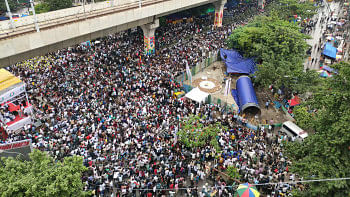Air quality in Bangladesh: A matter of great concern

Hopefully, we learned many lessons from the ongoing Covid-19 pandemic. One of them is the importance of oxygen for our survival. Normally it is available free of cost. As a matter of fact, we take the supply of oxygen for granted. Recently, however, we heard stories of Covid-19 patients with breathing difficulties moving from one hospital to another in search of oxygen. At one stage, oxygen became so scarce that many patients had to pay tens of thousands of taka as hospital bills only for the supply of oxygen. Yet we are alarmed to find how we have been polluting the air that is our main source of oxygen supply.
Air quality in Bangladesh was the worst in the world, while its capital Dhaka, was the second most polluted city in 2020, in terms of air pollution, said a global report (DS, March 18, 2021). "South Asia remained the most polluted region of the world with Bangladesh, India and Pakistan sharing 42 of the 50 most polluted cities worldwide," according to IQAir's global air quality data platform in its World Air Quality Report 2020. The three countries just mentioned, are also at the top of the list of countries with the worst air quality.
The report published recently said that the average annual PM 2.5 concentrations in Bangladesh was 77.1 microgrammes per cubic metre (mcg/m3) of air, which is seven times above WHO's exposure recommendation. PM refers to particulate matter in air. It consists of a mixture of solid and liquid particles suspended in the air. While particles with a diameter of 10 microns (micrometres) or less, denoted as PM 10, can penetrate and lodge deep inside the lungs, the smaller particles with a diameter of 2.5 microns or less, denoted as PM 2.5, are the more damaging to health as they can penetrate the lung barrier and enter the blood system.
Researchers from IQAir, a global air quality information and Swiss-based tech company, analysed pollution data from 106 countries, specifically measuring PM 2.5 that can cause serious health risks. "An estimated 13-22 percent of deaths in this region are linked to the health effects of air pollution exposure, with associated estimated costs equating to 7.4 percent of the region's GDP," the report said. Obviously, the cost due to air pollution is huge.
Chronic exposure to particulate matter (PM 10 and PM 2.5) can cause cardiovascular and respiratory diseases, as well as lung cancer. There is a close correlation between exposure to high concentrations of small particulates (PM 10 and PM 2.5) and increased mortality or morbidity. Conversely, when concentrations of small and fine particulates are reduced, related mortality will also go down. This correlation helps policymakers to plan the population's health improvements if air pollution is reduced.
Small particulate pollution has health impacts even at very low concentrations. Therefore, the WHO 2005 guideline limits aim to achieve the lowest achievable concentrations of PM. The air quality guideline values for PM 2.5 are 10 mcg/m3 for annual mean and 25 mcg/m3 for 24-hour mean. The corresponding values for PM 10 are 20 mcg/m3 and 50 mcg/m3..
According to the report, only 24 out of 106 monitored countries met the WHO's annual guidelines for PM 2.5 in 2020, even though air quality improved globally due to the Covid-19 pandemic. "The year 2020 brought an unexpected dip in air pollution. In 2021, we will likely see an increase in air pollution due to human activity again," said Frank Hammes, CEO of IQAir. Here we find a correlation between air quality and the Covid-19 pandemic. Human activities were curtailed significantly in many countries due to the lockdowns. This means that there were less discharge of exhaust from automobiles and fossil fuel based power plants, fewer pollutants from industries and less construction works. Obviously, these are the major sources of air pollution in most countries. Taking lessons from the pandemic, we can plan to reduce the air pollution in Bangladesh, if we take the following steps:
i) Introduce mass transport facilities in the major cities as early as possible. This will reduce the number of automobiles on the streets, ease traffic jam, increase the average speed of vehicles and thus reduce emission of exhaust gases. ii) Ensure that all automobiles which run on petrol or diesel use catalytic converters to reduce pollutants from the exhaust gases. iii) Drastically reduce import duties on electric cars which produce no exhaust gases so that they gradually replace most petrol and diesel fuel based automobiles. iv) Encourage people to walk or ride bicycles to go to work. For this we need to clear all footpaths of shops and stored construction materials. In addition, bicycle lanes should be provided along all the busy roads in cities. v) Keep streets clean and dust free so that no dust can be blown in the air by strong winds or by speedy vehicles. vi) Reduce dependence on coal, oil and gas while planning the electric power system and increase use of renewable energy and nuclear energy for power generation. Retire all old and inefficient fossil fuel based power plants and, if necessary, replace them with modern and more efficient combined cycle power plants. vii) Strictly enforce compliance of environmental protection laws by all industries. viii) Cover all major construction sites with canopies so that no dust can escape to the atmosphere. ix) Reduce use of burned bricks in construction of buildings and use concrete hollow blocks instead in order to reduce burning of bricks around localities. Concrete hollow blocks provide better insulation against heat or cold than burned solid bricks. x) For all outdoor activities, encourage people to wear masks for protection against PM 10 and PM 2.5.
It may be noted that air quality of major cities around the world is constantly monitored by IQAir and the information is available online around the clock. It is worth noting that the air quality of Dhaka improved significantly on March 26, 2021. Dhaka moved from being the second most polluted city to 12th position on that day because it was a national holiday in Bangladesh. Even with reduced air pollution, it was classified as "unhealthy". On the following day, it again jumped to the second position, next only to Beijing, and was classified as "very unhealthy". This means we have to go a long way to clean our air.
It should be remembered that when the outside air is polluted, the indoor air is also almost equally as polluted. To reduce indoor pollution, commercial air purifiers are available in the market. Air purifiers provide good relief to patients suffering from respiratory ailments. Uses of air purifiers should be made compulsory in closed environments like shopping malls, community centres, cinema and theatre halls and other closed places where large gatherings of people take place.
These steps, if undertaken seriously, will hopefully reduce air pollution significantly and help to decrease both mortality and morbidity rates due to respiratory diseases. Lastly, we must remember that the air quality of Bangladesh has reached a stage that it will be suicidal for us not to take the necessary steps seriously and urgently, to reduce air pollution to an acceptable level, as recommended by WHO.
Dr Abdul Matin is a retired nuclear engineer and a former Professor of Dr Rashid Chair at Buet.

 For all latest news, follow The Daily Star's Google News channel.
For all latest news, follow The Daily Star's Google News channel. 



Comments